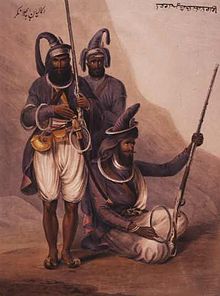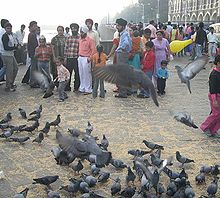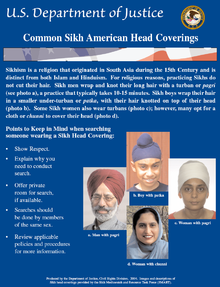- Dastar
-
For the village in Azerbaijan, see Dəstər. For the United States Supreme Court case, see Dastar Corp. v. Twentieth Century Fox Film Corp..
Part of a series on
Sikh practices and discipline
Five Banis · Five Ks · Five Evils · Five Virtues · Simran · Sewa · Three pillars · Sikh Rehat Maryada This box: view · A Sikh man with a cellphone wearing a dastar
A Dastar (Punjabi: ਦਸਤਾਰ, dastār, from Persian: دستار) or Pagṛi (Punjabi: ਪਗੜੀ) is a mandatory headgear for Sikhs. Dastar is very clearly associated with Sikhism and is an important part of the Sikh culture. Wearing a Sikh turban is mandatory for all Amritdhari (baptized) Sikhs (also known as Khalsa).
Among the Sikhs, the turban is an article of faith that represents honour, self-respect, courage, spirituality, and piety. The Khalsa Sikhs, who adorn the Five Ks, wear the turban partly to cover their long, uncut hair (kesh). The turban is mostly identified with the Sikh males, although some Sikh women also wear turban. The Khalsa Sikhs regard the turban as an important part of the unique Sikh identity. They are easily recognizable by their distinctive turbans.
Contents
History
The turban has been an important part of the Sikh culture since the time of the First Guru. Guru Angad Dev honoured Guru Amar Das ji with a special turban when he was declared the next Guru. At the time when Guru Ram Das's passed away, Guru Arjan Dev was honoured with the turban of Guruship.
- Marne di pag Pirthiye badhi. Guriyaee pag Arjan Ladhi[1]
Guru Gobind Singh, the last human Sikh Guru, wrote:
- Kangha dono vaqt kar, paag chune kar bandhai. ("Comb your hair twice a day and tie your turban carefully, turn by turn.")
Bhai Rattan Singh Bhangu, one of the earliest Sikh historians, wrote in Sri Gur Panth Parkash:[2]
- Doi vele utth bandhyo dastare, pahar aatth rakhyo shastar sambhare
- Kesan ki kijo pritpal, nah(i) ustran se katyo vaal
- Tie your turban twice a day and wear shaster (weapons to protect dharma), and keep them with care, 24 hours a day.
- Take good care of your hair. Do not cut or damage your hair.
Significance
 Nihang Abchal Nagar (Nihangs from Hazur Sahib), 1844. Shows turban-wearing Sikh soldiers with chakrams
Nihang Abchal Nagar (Nihangs from Hazur Sahib), 1844. Shows turban-wearing Sikh soldiers with chakrams
In the Khalsa society, the turban signifies many virtues:
- Spirituality
- The turban is a symbol of spirituality and holiness in Sikhism.
- Honour and self-respect
- The turban is also a symbol of honour and self-respect. In the Punjabi culture, those who have selflessly served the community are traditionally honoured with turbans.
- Responsibility
- Rasam Pagri ("turban ceremony") is a ceremony in North India. Rasam Pagri takes place, when a man passes away and his oldest son takes over the family responsibilities by tying the turban in front of a large gathering. It signifies that now he has shouldered the responsibility of his father and he is the head of the family.
- Piety and moral values
- The turban also signifies piety and purity of mind. In the Punjabi society, the Khalsa Sikhs are considered as protectors of the weak, even among the non-Sikhs. In the older times, the Khalsa warriors moved from village to village at night, during the battles. When they needed a place to hide from the enemy, the womenfolk, who had a very high degree of trust in them used to let them inside their houses. It was a common saying in Punjab: Aye nihang, booha khol de nishang ("The nihangs are at the door. Dear woman! go ahead open the door without any fear whatsoever.")
- Courage
- The Sikh warriors (Khalsa) wear turban, partly to cover their long hair, which is never cut, as per the wish of their last human Guru, Guru Gobind Singh. There are many references in the Sikh history that describe how Guru Gobind Singh personally tied beautiful dumalas (turbans) on the heads of both his elder sons Ajit Singh and Jujhar Singh, and how he personally gave them arms, decorated them like bridegrooms, and sent them to the battlefield at Chamkaur Sahib where they both died as martyrs. A saffron-colored turban is especially identified with courage, sacrifice and martyrdom.
- Friendship and relationship
- Pag Vatauni ("exchange of turban") is a Punjabi custom, in which the people exchange turbans with their closest friends. Once they exchange turbans they become friends for life and forge a permanent relationship. They take a solemn pledge to share their joys and sorrows under all circumstances. Exchanging turban is a glue that can bind two individuals or families together for generations.
- Sayings
There are many Punjabi idioms and proverbs that describe how important is a turban in one's life. Bhai Gurdas writes:[3]
- Tthande khuhu naike pag visar(i) aya sir(i) nangai
- Ghar vich ranna(n) kamlia(n) dhussi liti dekh(i) kudhange
- ("A person, after taking a bath at the well during winter time, forgot his turban at the well and came home bareheaded.
- When the women saw him at home without a turban, they thought someone had died and they started to cry.")
Sign of Sikhism
The turban is considered an important part of the unique Sikh identity. The bare head is not considered appropriate as per gurbani. If a Sikh wants to become one with his/her Guru, he/she must look like a guru (wear a turban). Guru Gobind Singh stated:
- Khalsa mero roop hai khaas. Khalse me hau karo niwas.
- ("Khalsa is a true picture of mine. I live in Khalsa.")
Maintaining long hair and tying turban is seen as a token of love and obedience of the wishes of Sikh gurus. A quote from Sikhnet:[4]:
“ The turban is our Guru's gift to us. It is how we crown ourselves as the Singhs and Kaurs who sit on the throne of commitment to our own higher consciousness. For men and women alike, this projective identity conveys royalty, grace, and uniqueness. It is a signal to others that we live in the image of Infinity and are dedicated to serving all. The turban doesn't represent anything except complete commitment. When you choose to stand out by tying your turban, you stand fearlessly as one single person standing out from six billion people. It is a most outstanding act. ” Styles of turbans
- Men's Double Patti (Nok)
- This is a very common Sikh turban style. It is very common in Punjab, India. The Nok is a double wide turban. 6 meters of turban cloth are cut in half, then into two 3 meter pieces. They are then sewn together to make it Double wide, thus creating a "Double Patti," or a Nok turban. This turban is larger than most Sikh dastars, but contains fewer wraps around the head.
- Chand Tora Dhamala
- This style of turban is generally worn by Nihang Sikhs . This is a warrior style turban meant for going into battle. The "Chand Tora" is a metal symbol consisting of a crescent and a double edged sword symbolising shiva according to various sources such as sikhnet, sarbloh.info nihang.org, it is held in place at the front of the turban by woven chainmail cord tied in a pattern within the turban to protect the head from slashing weapons.
- Amritsar Dhamala
- This is the most common Dhamala turban. It consists of:
- one 5 meter piece (Pavo Blue)
- one 11 meter piece any color, commonly sabz (white) and pavo blue. Both pieces are 35 cm wide, and referred to in Amritsar as Dhamala Material.
- Basic Dhamala
- This is a very simple and basic Dhamala Sikh turban. This is the most popular turban among young Sikhs of the Akhand Kirtani Jatha and also quite popular among those of Damdami Taksal in countries like America, the United Kingdom and Canada.
- General Sikh Turban
- Another common Sikh turban style for men. Unlike the "double patti" turban, the turban is longer and goes 7 times around the head. If you use the "Notai" technique and have a big joora (hair knot), do not make it right in front at your forehead. You will end up tying the turban on the joora, and it will make your turban look very high and big.
- Patka/Keski Turban
- This is a common sikh turban among young boys. It is normally used as more of a casual Pugree, or sometimes for sports. Commonly, this is a peela (shade of yellow) coloured turban.
- These are the basic Sikh Pugaree types. Turban theory states that the main pugaree types are starting points, and anyone can invent their own turban styles. But keep in mind the colour, and wrap type, and amount will differentiate the LOS between pugrees, so feel free to play with LOS levels, and increase or decrease your LOS simply by trying Kavi over Peta for example.
In May 2009, The Times of India reported that British researchers were trying to make a "bulletproof turban" that would allow the Sikhs in the British police to serve in firearms units.[5]
Harassment faced by turban-wearing Sikhs
After the September 11, 2001 attacks in USA, many turban-wearing Sikhs faced assaults by some Americans who confused them with the Arabs (who were being associated with terrorism).[6][7] The United States Department of Justice worked with the Sikh American Legal Defense and Education Fund (SALDEF) to issue a poster aimed at getting the Americans acquainted with the Sikh turbans.[8]
Conflicts with civil law
In modern times, there have been conflicts between Sikhs – especially those outside India – and laws which conflict with always wearing a turban.
Sikh soldiers refused to wear helmets during World War I and World War II. Many Sikhs have refused to remove the turban even in jails. Sikh scholar and social activist Bhai Randhir Singh underwent a fast to be able to wear a turban in prison.
In the UK in 1982, the headmaster of a private school refused to admit an orthodox Sikh as a pupil unless he removed the turban and cut his hair. This led to the long legal battle, Mandla v. Dowell Lee.[9][10]
In Canada in 1990, the Supreme Court of Canada ruled that Baltej Singh Dhillon, an RCMP officer, should be allowed to wear a turban while on duty.[11]
In the United States in 2002, Jasjit Singh Jaggi, a Sikh traffic policeman employed with the New York Police Department, was forced to leave his job because he insisted on wearing a turban on duty. He petitioned with the New York Human Rights Commission, and in 2004 a US judge ruled that he should be reinstated.[12]
In France in 2004, the Sikh community protested against the introduction of a law prohibiting the display of any religious symbols in state-run schools.[13][14] The Shiromani Gurdwara Parbandhak Committee urged the French Government to review the bill, stating that the ban would have grave consequences for the Sikhs.[15] The Government of India discussed the matter with the French officials, who stated that an exception for turbaned Sikh boys in French public schools was not possible.[16]
In 2007, The Canadian government introduced new procedures for accommodation of Sikhs in regard to passport photos, driver licensing, and other legal licensing. This bill was also supported by the Sikh Council of Canada.
In April 2009, Capt. Kamaljit Singh Kalsi and 2nd Lt. Tejdeep Singh Rattan challenged a U.S. Army order that they remove their turbans and shave their beards.[17] In March 2010, Rattan became the first Sikh to graduate Army Officer School at Fort Sam Houston since the exemption was eliminated in 1984; a waiver was granted for his religion. Kalsi will also attend basic training.[18]
Helmet exemption
In several parts of the world, Sikh riders are exempted from wearing a helmet when riding a motorcycle, which cannot be done without removing the turban. These places include India, Malaysia, Singapore, Thailand, the United Kingdom, Australia and the Canadian provinces of British Columbia and Manitoba.[11]
In 2008, Baljinder Badesha, a Sikh man living in Brampton, Ontario, Canada, lost a court case in which he challenged a $110 ticket received for wearing a turban instead of a helmet while riding his motorcycle.[11][19][20]
See also
References
- ^ "Partakh Hari," Jiwni Guru Arjan Dev Ji, by Principal Satbir Singh
- ^ Bhai Rattan Singh Bhangu. Sri Gur Granth Parkash. Page 78.
- ^ Vara(n) Bhai Gurdas, Var 32, pauri 19
- ^ Learn How To Tie Different Sikh Turbans
- ^ Bulletproof turbans for Sikh cops. The Times of India. 8 May 2009.
- ^ "Sikh attacked in another hate crime in New York". CNN-IBN. 2008-01-27. http://ibnlive.com/news/sikh-attacked-in-another-hate-crime-in-new-york/57501-3.html. Retrieved 2008-01-27.
- ^ Vanessa Garnica (2003-04-18). "Sikhs: Turbans don't mean terrorism". The Oracle. http://media.www.usforacle.com/media/storage/paper880/news/2003/04/18/News/Sikhs.Turbans.Dont.Mean.Terrorism-1678001.shtml. Retrieved 2008-01-25.
- ^ "US initiative to explain turbans". The Tribune, Chandigarh. 2004-12-16. http://www.tribuneindia.com/2004/20041216/world.htm#4. Retrieved 2008-01-25.
- ^ "Turban or not turban — that is the question (Mandla v. Dowell Lee)". Liverpool Law Review (Netherlands: Springer) 5 (1): 75–90. March 1983. doi:10.1007/BF01079986.
- ^ Moore, Joan Brooke (1985). The politics of litigating discrimination : a case study of Mandla v. Dowell Lee (Thesis). University of Oxford. OCLC 123433705.
- ^ a b c Precedents buoy Sikh's turban fight, lawyer says
- ^ "Sikh policeman wins turban case". BBC News. 2004-04-30. http://news.bbc.co.uk/2/hi/americas/3673733.stm. Retrieved 2008-01-25.
- ^ Rana, Yudhvir (2004-01-06). "French turban ban gets Sikh group into action". The Times of India. http://timesofindia.indiatimes.com/articleshow/406775.cms. Retrieved 2008-01-25.
- ^ Ranvir Nayar (2004-01-17). "French Sikhs defend the turban". BBC News. http://news.bbc.co.uk/2/hi/europe/3403775.stm. Retrieved 2008-01-25.
- ^ Rana, Yudhvir (2004-03-24). "SGPC urges French govt to review turban ban". The Times of India. http://timesofindia.indiatimes.com/articleshow/580148.cms. Retrieved 2008-01-25.
- ^ "France can't make exceptions on turban ban: Envoy". CNN-IBN. 2008-01-25. http://www.ibnlive.com/news/france-cant-make-exceptions-on-turban-ban-envoy/57330-3.html. Retrieved 2008-01-25.
- ^ "Sikhs fight Army over bans on turbans, uncut hair". CNN. 2009-04-15. http://edition.cnn.com/2009/US/04/15/us.sikhs.military/index.html. Retrieved 2009-04-25.
- ^ 1st Sikh in decades graduates Army Officer School
- ^ Sikhs have worn helmets 'throughout their history'
- ^ Douglas, Pam (2008-03-15). "Sikh, backers to appeal motorcycle helmet ruling". The Star (Toronto). http://www.thestar.com/News/GTA/article/346367. Retrieved 2010-05-01.
Categories:- Headgear
- Sikh religious clothing
Wikimedia Foundation. 2010.
Look at other dictionaries:
Dastar — est le nom donné au turban porté par les Sikhs. Le turban de couleur orange safran est en particulier associé au courage, au sacrifice et au martyr. Portail du monde indien Catégorie : Sikhisme … Wikipédia en Français
Dastar — Ein Sikh mit Dastar, 2007 Der Ausdruck Dastar (Panjabi: ਦਸਤਾਰ) bezeichnet den Turban der Sikhs, der vorwiegend von Männern getragen wird. (Synonym: Pagri. Punjabi: ਪੱਗੜ੍ਹੀ, Hindi: पगड़ी, Marathi: पगडी, Urdu: پگڑی) Inhaltsverzeichnis 1 … Deutsch Wikipedia
Dastar Corp. v. Twentieth Century Fox Film Corp. — Dastar Corp. v. Twentieth Century Fox Film Corp. Supreme Court of the United States Argued April 2, 2003 … Wikipedia
Dastar Bungga — Angaben Waffenart: Schutzwaffe … Deutsch Wikipedia
Dastar (disambiguation) — Dastar is:* a type of turban worn by Sikhs * the shorthand form of a United States Supreme Court case: Dastar Corp. v. Twentieth Century Fox Film Corp … Wikipedia
Dastar Bandhi — Bei der Dastar Bandhi oder der Dastar Bandhi Feier handelt es sich um die Einweihung eines männlichen Sikhs in die erwachsene Glaubensgemeinschaft. Zur Dastar Bandhi gehört immer ein Gottesdienst. Meist werden auch Verwandte und Freunde der… … Deutsch Wikipedia
dastar — I (Qax) bax dasdar I II (Culfa, Füzuli, Ordubad) bax dasdar II. – Dastari qonşıdan al, gətir (Ordubad) … Azərbaycan dilinin dialektoloji lüğəti
DASAR — (Dâstâr) f. Tellal, simsar … Yeni Lügat Türkçe Sözlük
Dastur Bandhi — Bei der Dastar Bandhi oder der Dastar Bandhi Feier handelt es sich um die Einweihung eines männlichen Sikhs in die erwachsene Glaubensgemeinschaft. Zur Dastar Bandhi gehört immer ein Gottesdienst. Meist werden auch Verwandte und Freunde der… … Deutsch Wikipedia
Sikh terms — The following list consists of concepts that are derived from both Sikh and Indian tradition. The main purpose of this list is to disambiguate multiple spellings, to make note of spellings no longer in use for these concepts, to define the… … Wikipedia
18+© Academic, 2000-2025- Contact us: Technical Support, Advertising
Dictionaries export, created on PHP, Joomla, Drupal, WordPress, MODx.Share the article and excerpts
Dastar
- Dastar
-
For the village in Azerbaijan, see Dəstər. For the United States Supreme Court case, see Dastar Corp. v. Twentieth Century Fox Film Corp..
Part of a series on
Sikh practices and discipline
Five Banis · Five Ks · Five Evils · Five Virtues · Simran · Sewa · Three pillars · Sikh Rehat Maryada


